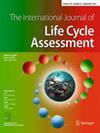一种评估非生物资源利用对未来资源可及性影响的新生命周期影响评估方法
IF 5.4
3区 环境科学与生态学
Q2 ENGINEERING, ENVIRONMENTAL
引用次数: 4
摘要
摘要目的将非生物资源作为影响类别纳入生命周期影响评价(LCIA)。最被广泛接受的LCIA方法是非生物资源枯竭潜力(ADP)。然而,大量研究表明了ADP方法的局限性,例如忽略了可以回收的资源。本文旨在开发一种综合客观的评估资源利用对后代影响的方法,该方法可在生命周期的不同阶段使用。方法基于上述研究目标,本文提出了一种评估当前资源利用对非生物资源可及性影响的新方法——非生物资源预期耗散势(AEDP)法。该方法基于耗散流量的不同端点,将资源采掘率替换为全球年耗散率,并在总储量中加入人为储量,得到表征因子AEDPs。最后,对四个影响类别进行加权,以获得资源使用的最终影响分数。结果新方法的结果是自然储量、耗散率和资源提取率的多维反映。AEDPs与ADPs的比较显示两者之间存在差异,但差异不显著。在AEDP公式中,总储量的较大次幂会过分强调自然储量对表征因子的影响。此外,其他自然保护区数据作为敏感性分析的替代指标。结论该评价方法能更准确地评价未来非生物资源利用的影响。它可以用于任何生命周期阶段,以支持相关利益相关者的决策。但是,需要开发一个更广泛的数据库来计算更多的特征因素。此外,储量数据在表征因素中的压倒性优势掩盖了其他维度的影响。因此,需要进一步研究以提高该方法的可操作性和合理性。本文章由计算机程序翻译,如有差异,请以英文原文为准。
A new life cycle impact assessment methodology for assessing the impact of abiotic resource use on future resource accessibility
Abstract Purpose Abiotic resource is included as an impact category in life cycle impact assessment (LCIA). The most widely accepted LCIA method is abiotic resource depletion potential (ADP). However, numerous studies have illustrated the limitations of the ADP method, such as the neglect of resources that can be recycled. This paper aims to develop a comprehensive and objective method for assessing the impact of resource use on future generations, which can be used at different stages of the life cycle. Methods Based on the above research objectives, this paper proposes a new method, the abiotic resource expected dissipation potential (AEDP) method, for assessing the impacts of current resource use on the abiotic resource accessibility. The method is divided into four impact categories based on different endpoints of the dissipative flow and replaces the resource extraction rate with the global annual dissipation rate and adds anthropogenic stocks to the total reserves, resulting in the characterization factor AEDPs. Finally, the four impact categories are weighted to obtain a final impact score for resource use. Results Results of the new method are presented as a multi-dimensional reflection of natural reserves, dissipation rates, and extraction rates of resources. The comparison between AEDPs and ADPs revealed differences between them, but they were not significant. A higher power of the total reserves in the AEDP formula can overemphasize the effect of natural reserves on the characterization factor. Furthermore, other natural reserve data was used as alternative indicators in the sensitivity analysis. Conclusion The new assessment method enables the future impacts of abiotic resource use to be more accurately assessed. It can be used at any life cycle stage to support relevant stakeholder decision-making. However, a broader database is required to be developed to calculate more characterization factors. Moreover, the over-dominance of reserve data in the characterization factors overshadows the influence of other dimensions. Consequently, further research is necessary to improve the operability and plausibility of this method.
求助全文
通过发布文献求助,成功后即可免费获取论文全文。
去求助
来源期刊
CiteScore
10.60
自引率
10.40%
发文量
100
审稿时长
8-16 weeks
期刊介绍:
The International Journal of Life Cycle Assessment (Int J Life Cycle Assess) is the first journal devoted entirely to Life Cycle Assessment and closely related methods. LCA has become a recognized instrument to assess the ecological burdens and impacts throughout the consecutive and interlinked stages of a product system, from raw material acquisition or generation from natural resources, through production and use to final disposal. The Int J Life Cycle Assess is a forum for scientists developing LCA and LCM (Life Cycle Management); LCA and LCM practitioners; managers concerned with environmental aspects of products; governmental environmental agencies responsible for product quality; scientific and industrial societies involved in LCA development, and ecological institutions and bodies.

 求助内容:
求助内容: 应助结果提醒方式:
应助结果提醒方式:


